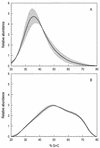Effective recovery of bacterial DNA and percent-guanine-plus-cytosine-based analysis of community structure in the gastrointestinal tract of broiler chickens
- PMID: 9758849
- PMCID: PMC106608
- DOI: 10.1128/AEM.64.10.4084-4088.1998
Effective recovery of bacterial DNA and percent-guanine-plus-cytosine-based analysis of community structure in the gastrointestinal tract of broiler chickens
Abstract
A DNA-based, direct method for initial characterization of the total bacterial community in ileum and cecum of the chicken gastrointestinal (GI) tract was developed. The efficiencies of bacterial extraction and lysis were >95 and >99%, respectively, and therefore the DNA recovered should accurately reflect the bacterial communities of the ileal and cecal digesta. Total bacterial DNA samples were fractionated according to their percent G+C content. The profiles reflecting the composition of the bacterial community were reproducible within each compartment, but different between the compartments of the GI tract. This approach is independent of the culturability of the bacteria in the consortium and can be used to improve our understanding of how diet and other variables modulate the microbial communities of the GI tracts of animals.
Figures

 ) and cumulative recovery (
) and cumulative recovery ( ) of bacteria from ileal digesta samples during the bacterial recovery process. The data were obtained by direct microscopic enumeration of bacterial cells in the supernatant following each round of differential, low-speed centrifugation. Percent removal is based on the number of cells present in the starting ileal digesta sample. Error bars indicate 1 standard error of the mean (n = 4).
) of bacteria from ileal digesta samples during the bacterial recovery process. The data were obtained by direct microscopic enumeration of bacterial cells in the supernatant following each round of differential, low-speed centrifugation. Percent removal is based on the number of cells present in the starting ileal digesta sample. Error bars indicate 1 standard error of the mean (n = 4).


References
-
- Adami A, Cavazzoni V. An experimental standard pattern of assessing the caecal microflora of chicken. Ann Microbiol Enzimol. 1993;43:329–336.
-
- Arun K B, Kumar M C, York M D, Pomeroy B S. Direct immunofluorescent technique in diagnosis of experimental salmonellosis of turkeys. Avian Dis. 1974;19:59–65. - PubMed
-
- Barnes E. The intestinal microflora of poultry and game birds during life and after storage. J Appl Bacteriol. 1979;46:407–419. - PubMed
-
- Barnes E M, Mead G C, Barnum D A. The intestinal flora of the chicken in the period 2 to 6 weeks of age, with particular reference to the anaerobic bacteria. Br Poult Sci. 1972;13:311–325. - PubMed
-
- Barrow P. Probiotics for chickens. In: Fuller R, editor. Probiotics: the scientific basis. London, United Kingdom: Chapman & Hall; 1992. pp. 225–257.
Publication types
MeSH terms
Substances
LinkOut - more resources
Full Text Sources
Other Literature Sources
Molecular Biology Databases

